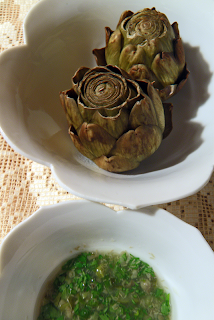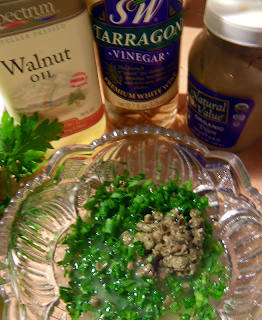 |
| A Beautiful Combination |
Recipe inspired by The Complete Book of Herbs
Even though I had no idea what it means, ravigote is a
compelling word, especially when pronounced with a French accent. According to
the Huffington
Post Food Encyclopedia, ravigote is derived from the verb ravigoter,
meaning “to perk up,” also translated as “to give new life to.” There are two
types of ravigote: warm and cold. This recipe is for a cold ravigote, which is
essentially a highly flavored vinaigrette. Ravigote is often used as a topping for
fish and meat, and occasionally vegetables.
 |
| Balanced Mix |
Though I wouldn’t add any nontraditional herbs, any combination ingredients that “perks up” whatever it’s spooned over will be true to the name “ravigote.” I like using a small amount of neutral, light tasting oil like walnut or sunflower, to avoid overpowering the herby taste. Some chefs prefer using olive oil, and use quite a bit more oil. Your choice.
 |
| Make an X for Hydration |
serves 4
4 medium artichokes
Water for steaming
1½ tbsp. tarragon vinegar
1 tsp. smooth Dijon mustard
½ tsp. fresh lemon juice
2 tbsp. water
½ tsp. salt
2 tbsp. finely chopped chives
2 tbsp. finely chopped parsley
1 tbsp. finely chopped capers
2 tsp. finely chopped cornichons
2 tbsp. walnut oil
Artichokes
Allow 1½ - 2 hours to cook the artichokes, if possible.
Learn more about why
I use this artichoke cooking method here. Trim spikey tops off artichokes
with a knife. Hydrate artichokes by cutting off the stem close to the ‘choke.
Cut an X into the stem end, an inch or so up into the artichoke heart. Let soak
in water 2” deep, stem side down, for 20 minutes to 1 hour. You can use the pot
that you’ll cook them in.
Remove artichokes, put steamer into pot and add water to
steam if necessary. Steam 25 – 45 minutes, depending upon the size. If very
small, it might take only 20 minutes. After 20-25 minutes, test every 5 minutes
by pulling off a leaf and testing it with your teeth. Be sure to check the
water level periodically so ‘chokes don’t boil dry.
Or use your favorite artichoke preparation method.
Ravigote Sauce
Stir tarragon vinegar together with Dijon mustard until
smooth. Stir in lemon juice, water, and salt. Stir in chopped parsley and
chives until uniformly distributed. Stir in finely chopped capers and
cornichons. Stir in walnut oil.
Serve with hot or cold artichokes, or on grilled fish such
as salmon.

No comments:
Post a Comment